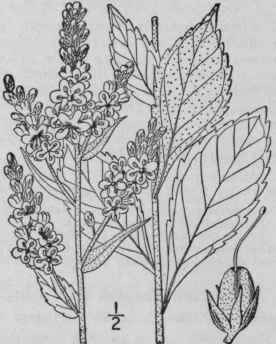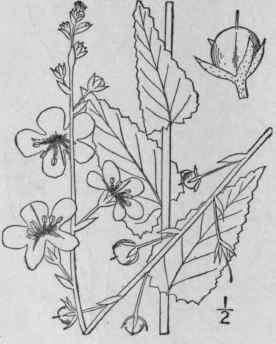1. Verbascum [Tourn.] L. Sp. Pl. 177. 1753
Description
This section is from the book "An Illustrated Flora Of The Northern United States, Canada And The British Possessions Vol3", by Nathaniel Lord Britton, Addison Brown. Also available from Amazon: An Illustrated Flora of the Northern United States, Canada and the British Possessions. 3 Volume Set..
1. Verbascum [Tourn.] L. Sp. Pl. 177. 1753
Biennial or rarely perennial, mostly tall and erect herbs, with alternate dentate pinnatifid or entire leaves, and rather large yellow purple red or white flowers, in terminal spikes, racemes or panicles. Calyx deeply 5-cleft or 5-parted. Corolla flat-rotate or slightly concave, 5-lobed, the lobes a little unequal, the upper exterior, at least in the bud. Stamens 5, inserted on the base of the corolla, unequal, all anther-bearing; filaments of the 3 upper stamens, or of all 5, pilose; anther-sacs confluent into one. Ovules numerous; style dilated and flattened at the summit. Capsule globose to oblong, septicidally 2-valved, many-seeded, the valves usually 2-cleft at the apex. Seeds rugose, not winged. [The Latin name of the great mullen; used by Pliny.]
About 125 species, natives of the Old World. Besides the following, another is naturalized in the western United States. Type species: Verbascum Thapsus L.
Plants densely woolly; flowers in dense terminal spikes, or spike-like racemes. Leaves strongly decurrent on the stem.
1. V. Thapsus.
Leaves not decurrent, or but slightly so.
2. V. phlomoides.
Leaves white-tomentose beneath; flowers in large terminal panicles.
3. V. Lychnitis.
Plant glabrous or sparingly glandular; flowers racemose.
4. V. Blattaria.
1. Verbascum Thapsus L. Great Mullen. Velvet Or Mullen Dock
Fig. 3735
Verbascum Thapsus L. Sp. Pl;. 177. 1753.
Erect, stout, simple or with some erect branches, densely woolly all over with branched hairs; stem 2°-7° high, wing-angled by the bases of the decurrent leaves. Leaves oblong, thick, acute, narrowed at the base, dentate or denticulate, 4-12' long, the basal ones borne on margined petioles; flowers yellow, 8"-12" broad, sessile, numerous in dense elongated spikes rarely branched above; stamens unequal, the three upper shorter with white hairy filaments and short anthers, the two lower glabrous or nearly so with larger anthers; capsule about 3' high, slightly longer than the woolly calyx.
In fields and waste places, Nova Scotia to South Dakota, California, Florida and Kansas. Often a troublesome weed. Naturalized from Europe. Native also of Asia. Among some 40 English names are hedge-, hig- or high-taper. Candlewick. Cow's or bullock's-lungwort. Aaron's- or Adam's-rod or -flannel. Feltwort. Hare's-beard. Jacob's-, Jupiter's- or Peter's-staff. Ice-leaf. Torches. Flannel-leaf. Old man's-flannel or blanket-leaf. Woolen, i. e., mullen. Shepherd's-club. Velvet-plant. June-Sept.


2. Verbascum Phlomoides L. Clasp-Ing-Leaved Mullen
Fig. 3736
Verbascum phlomoides L. Sp. Pl. 1194. 1753.
Stem rather stout, usually simple, 1°-4° high. Leaves oblong to ovate-lanceolate, crenate, crenulate, or entire, woolly-tomen-tose on both sides, sessile or somewhat clasping, or slightly decurrent on the stem, or the lower often petioled with truncate or subcordate bases; flowers yellow, or cream-color, 1' broad or more, usually in a solitary elongated tomentose spike-like raceme; pedicels clustered, shorter than the calyx; stamens as in V. Thapsus; capsule 4" -5" long, exceeding the tomentose calyx.
Eastern Massachusetts to Kentucky. Ad-ventive or fugitive from Europe or eastern Asia. June-Aug.
3. Verbascum Lychnitis L. White Mullen
Fig. 3737
Verbascum Lychnitis L. Sp. Pl. 177. 1753.
Stem angled, rather stout, paniculately branched above, 2°-4 1/2° high, densely covered, as well as the lower surfaces of the leaves, with a white canescent nearly stellate pubescence. Leaves oblong, ovate or oblong-lanceolate, crenate-dentate, 2'-7' long, the upper acute, sessile, but not decurrent on the stem, the lower obtuse or acute at the apex and narrowed into margined petioles; flowers in a large terminal panicle, racemose on its branches, white or cream-color, 5"-6" broad, nearly sessile; pilose hairs of the 3 shorter filaments white; capsule about 2" high, equalling or exceeding the calyx.
In fields and waste places, Ontario to New Jersey and Pennsylvania. Reported from Kansas. Naturalized from Europe. Native also of Asia. June-Sept. Its down once used for lighting, hence Lichnitis, lamp.

4. Verbascum Blattaria L. Moth Mullen
Fig. 3738
Verbascum Blatteria L. Sp. Pl. 178. 1753.
Stem erect, strict, slender, terete, glabrous or sparingly glandular-pubescent, usually quite simple, 2°-6° high. Leaves oblong, ovate or lanceolate, dentate, laciniate, or pinnatifid, acute or acuminate, the upper 1/2'-2 1/2' long, truncate or cordate-clasping at the base, the lower and basal ones sessile or somewhat petioled, sometimes 1° long, seldom present at flowering time; raceme 1°-2° long, loose; pedicels spreading, 1/2'-1' long, bracted at the base; corolla yellow or white, about 1' broad, with brown marks on the back; filaments all pilose with violet hairs; capsule depressed-globose, 3" in diameter, longer than the calyx.
In fields and waste places, Quebec to Florida, west to Oregon and California. Naturalized from Europe. Native also of Asia. June-Nov. Said to repel the cockroach (Blatta), whence the name Blattaria; frequented by moths, hence moth-mullen.
Verbascum virgatum Stokes, a similar Old World species, found on Cape Breton Island and naturalized in the Pacific States, has fruiting pedicels shorter than the capsules.

Continue to:


